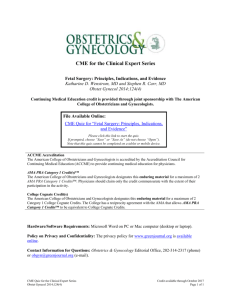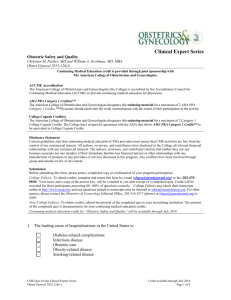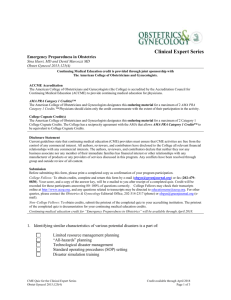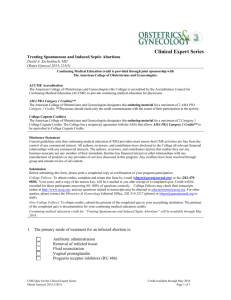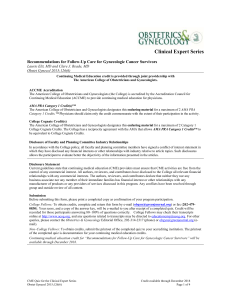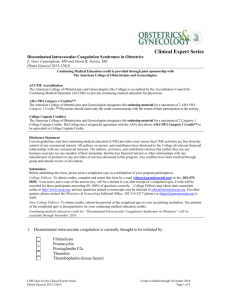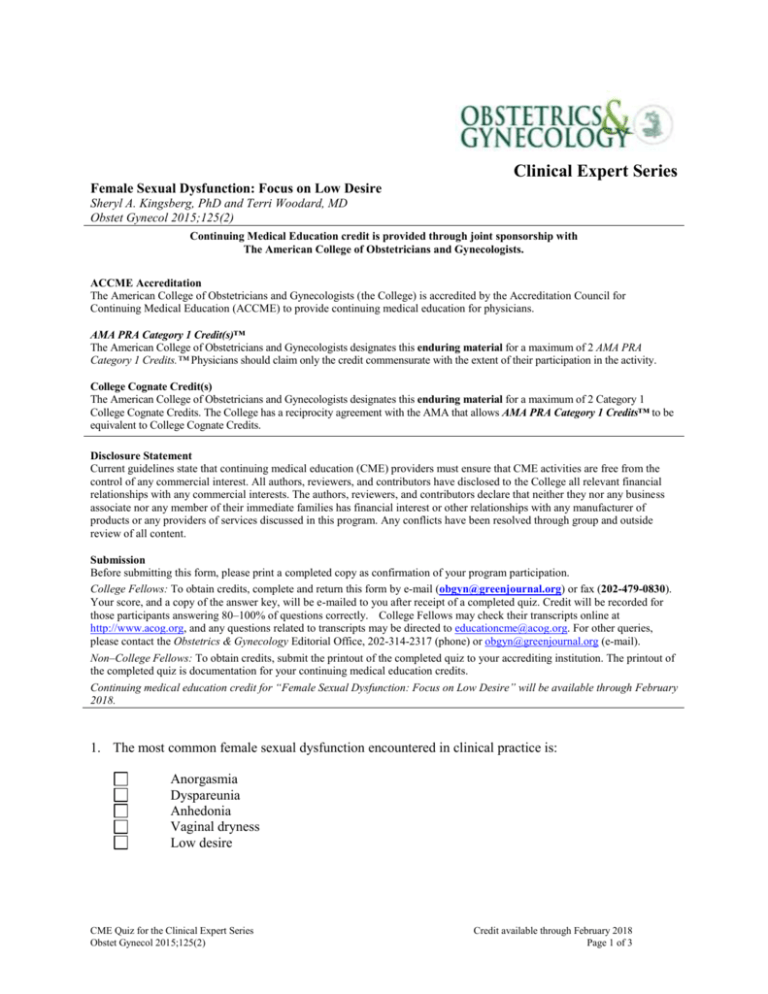
Clinical Expert Series
Female Sexual Dysfunction: Focus on Low Desire
Sheryl A. Kingsberg, PhD and Terri Woodard, MD
Obstet Gynecol 2015;125(2)
Continuing Medical Education credit is provided through joint sponsorship with
The American College of Obstetricians and Gynecologists.
ACCME Accreditation
The American College of Obstetricians and Gynecologists (the College) is accredited by the Accreditation Council for
Continuing Medical Education (ACCME) to provide continuing medical education for physicians.
AMA PRA Category 1 Credit(s)™
The American College of Obstetricians and Gynecologists designates this enduring material for a maximum of 2 AMA PRA
Category 1 Credits.™ Physicians should claim only the credit commensurate with the extent of their participation in the activity.
College Cognate Credit(s)
The American College of Obstetricians and Gynecologists designates this enduring material for a maximum of 2 Category 1
College Cognate Credits. The College has a reciprocity agreement with the AMA that allows AMA PRA Category 1 Credits™ to be
equivalent to College Cognate Credits.
Disclosure Statement
Current guidelines state that continuing medical education (CME) providers must ensure that CME activities are free from the
control of any commercial interest. All authors, reviewers, and contributors have disclosed to the College all relevant financial
relationships with any commercial interests. The authors, reviewers, and contributors declare that neither they nor any business
associate nor any member of their immediate families has financial interest or other relationships with any manufacturer of
products or any providers of services discussed in this program. Any conflicts have been resolved through group and outside
review of all content.
Submission
Before submitting this form, please print a completed copy as confirmation of your program participation.
College Fellows: To obtain credits, complete and return this form by e-mail (obgyn@greenjournal.org) or fax (202-479-0830).
Your score, and a copy of the answer key, will be e-mailed to you after receipt of a completed quiz. Credit will be recorded for
those participants answering 80–100% of questions correctly. College Fellows may check their transcripts online at
http://www.acog.org, and any questions related to transcripts may be directed to educationcme@acog.org. For other queries,
please contact the Obstetrics & Gynecology Editorial Office, 202-314-2317 (phone) or obgyn@greenjournal.org (e-mail).
Non–College Fellows: To obtain credits, submit the printout of the completed quiz to your accrediting institution. The printout of
the completed quiz is documentation for your continuing medical education credits.
Continuing medical education credit for “Female Sexual Dysfunction: Focus on Low Desire” will be available through February
2018.
1. The most common female sexual dysfunction encountered in clinical practice is:
Anorgasmia
Dyspareunia
Anhedonia
Vaginal dryness
Low desire
CME Quiz for the Clinical Expert Series
Obstet Gynecol 2015;125(2)
Credit available through February 2018
Page 1 of 3
2. The diagnosis of low or absent sexual desire is based on criteria that requires:
A sexual diary
Coitus less than 2 times per month
A prior history of successful orgasm
A stable partner
Personal distress
3. A large national survey of over 2,000 U.S. women revealed that those with hypoactive sexual desire
disorder had statistically significant increases in:
Hypertension
Divorce
Irritable bowel syndrome
First-trimester pregnancy loss
Mental health issues
4. The linear, four-stage model of sexual response was put forth by:
Basson
Kingsberg
Kinsey
Kaplan and Leif
Masters and Johnson
5. The intimacy-based circular model was put forth by:
Basson
Kingsberg
Kinsey
Kaplan and Leif
Masters and Johnson
6. Which of the models forms the basis of the Diagnostic and Statistical Manual of Mental Disorders,
Fifth Edition criteria of Female Sexual Interest and Arousal Disorder?
Linear, four stage model
Intimacy-based circular model
Revised linear three-phase model
Freudian model of approach and avoidance
Statistical norms modeling
CME Quiz for the Clinical Expert Series
Obstet Gynecol 2015;125(2)
Credit available through February 2018
Page 2 of 3
7. The most effective way to initiate a productive dialog about sexual dysfunction is to:
Wait for the patient to initiate the discussion
Display a sign in the waiting area about the prevalence of sexual problems
Post an online questionnaire on the practice’s web site
Provide paper pamphlets to each patient at check-in
Use open-ended questions as part of the review of systems
8. Psychotherapy for low sexual desire is typically favored when the dysfunction is:
Of less than 6 months in duration
Accompanied by anorgasmia
Refractory to hormonal therapy
Present after childbearing
Situational
9. In a 4-year open label extension safety summary of data of women receiving transdermal testosterone
by patch, the most common side effects were:
Virilization
Deepening of the voice
Acne
Breast loss
Application site irritation
10. For perimenopausal and postmenopausal women, oral testosterone formulations are not recommended
due to:
Cost
Variable absorption
Degradation by stomach acid
Dosing frequency
First pass effects on lipids
College ID Number:
Name:
Address:
City/State/Zip:
E-mail Address:
Actual time spent completing this activity (you may record up to 2 hours):
CME Quiz for the Clinical Expert Series
Obstet Gynecol 2015;125(2)
Credit available through February 2018
Page 3 of 3

